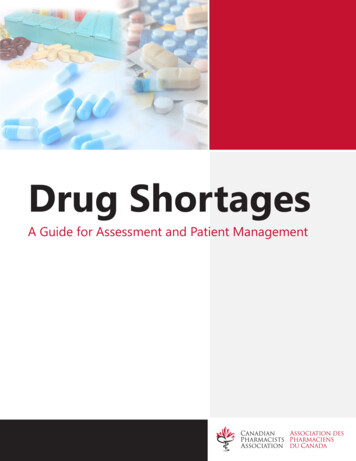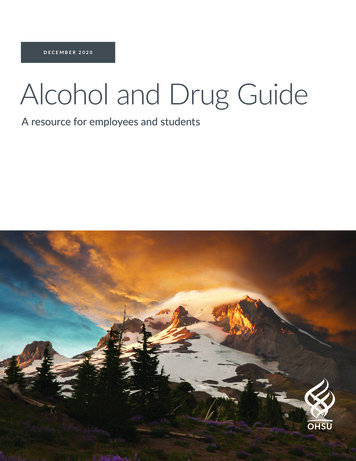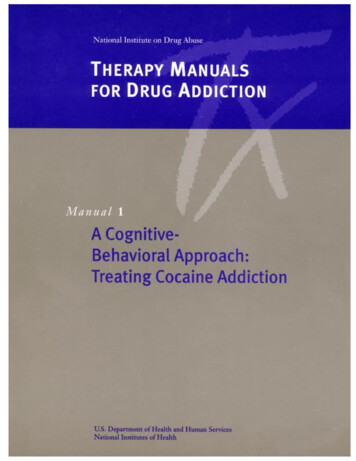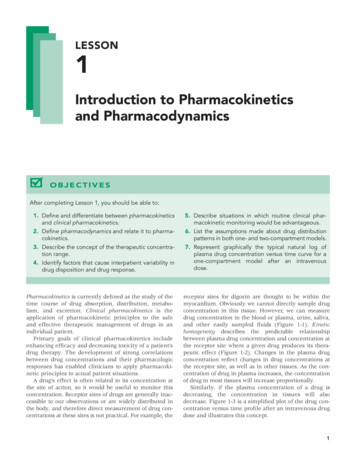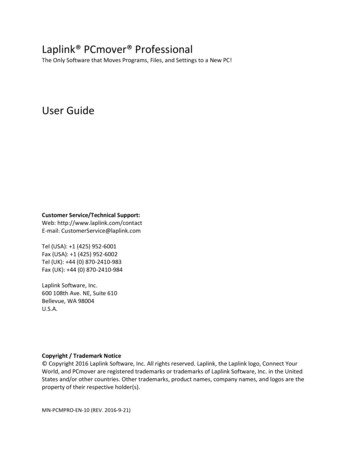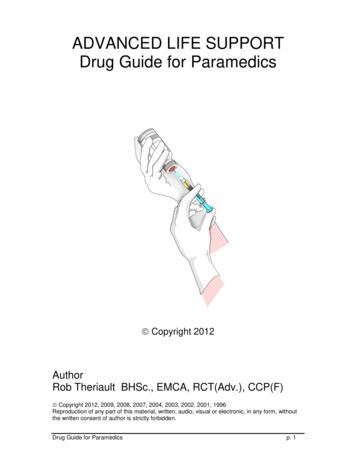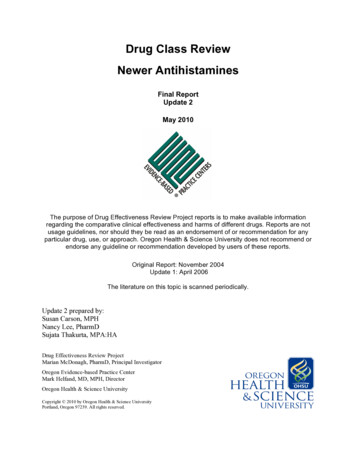
Transcription
Drug Class ReviewNewer AntihistaminesFinal ReportUpdate 2May 2010The purpose of Drug Effectiveness Review Project reports is to make available informationregarding the comparative clinical effectiveness and harms of different drugs. Reports are notusage guidelines, nor should they be read as an endorsement of or recommendation for anyparticular drug, use, or approach. Oregon Health & Science University does not recommend orendorse any guideline or recommendation developed by users of these reports.Original Report: November 2004Update 1: April 2006The literature on this topic is scanned periodically.Update 2 prepared by:Susan Carson, MPHNancy Lee, PharmDSujata Thakurta, MPA:HADrug Effectiveness Review ProjectMarian McDonagh, PharmD, Principal InvestigatorOregon Evidence-based Practice CenterMark Helfand, MD, MPH, DirectorOregon Health & Science UniversityCopyright 2010 by Oregon Health & Science UniversityPortland, Oregon 97239. All rights reserved.
Final Report Update 2Drug Effectiveness Review ProjectThe medical literature relating to this topic is scanned periodically. ter/DERP/about/methods.cfmfor description of scanning process). Prior versions of this report can be accessed at theDERP website.AntihistaminesPage 2 of 72
Final Report Update 2Drug Effectiveness Review ProjectTABLE OF CONTENTSINTRODUCTION . 6Purpose and Limitations of Systematic Reviews. 9Scope and Key Questions. 11METHODS . 12Study Selection and Inclusion Criteria. 12Populations . 12Interventions. 12Outcomes . 12Study Design . 13Literature Search. 13Data Abstraction. 13Study Selection . 14Validity Assessment . 14Data Synthesis . 15Public Comment . 15RESULTS . 15Overview . 15Key Question 1. For outpatients with seasonal or perennial allergic rhinitis or urticaria, do newerantihistamines differ in effectiveness?. 17Detailed Assessment . 18Adults . 18Seasonal allergic rhinitis . 18Direct evidence. 18Indirect evidence . 20Perennial allergic rhinitis. 20Direct evidence. 20Indirect evidence . 20Urticaria . 20Direct evidence. 20Indirect evidence . 22Children . 23Seasonal allergic rhinitis . 23Perennial allergic rhinitis. 23Urticaria . 26Key Question 2. For outpatients with seasonal or perennial allergic rhinitis or urticaria, do newerantihistamines differ in harms?. 26Summary of findings . 26Detailed assessment. 27Adults . 27Total withdrawals and withdrawals due to adverse events. 27Commonly reported adverse events. 27First-generation antihistamines compared with newer antihistamines . 27Cetirizine compared with loratadine . 27Levocetirizine compared with desloratadine . 28Cetirizine compared with fexofenadine . 28Desloratadine compared with fexofenadine . 28Astelin nasal spray compared with olopatadine nasal spray . 28Azelastine nasal spray compared with cetirizine . 29Electrocardiogram changes . 29Other. 29AntihistaminesPage 3 of 72
Final Report Update 2Drug Effectiveness Review ProjectChildren . 29Total withdrawals and withdrawals due to adverse events. 29Commonly reported adverse events. 29Electrocardiogram changes . 30Other. 30Key Question 3. Are there subgroups of patients based on demographics (age, racial groups, gender),concomitant medications (drug-drug interactions), co-morbidities (drug-disease interactions orpregnancy), for which one newer antihistamine is more effective or associated with fewer harms? . 31Summary of findings . 31Detailed assessment. 31Age, gender, race/ethnicity . 31Asthma. 31Atopic dermatitis . 31Pregnancy. 32SUMMARY OF THE EVIDENCE. 32REFERENCES . 36TABLESTable 1. Included drugs and their labeled indications . 7Table 2. Head-to-head trials in adults with seasonal allergic rhinitis . 18Table 3. Total Symptom Score change from baseline in head-to-head trials in adults with seasonalallergic rhinitis. 19Table 4. Head-to-head trials in adults with urticaria . 22Table 5. Outcomes from trials in children with perennial allergic rhinitis . 24Table 6. Summary of the evidence. 33FIGURESFigure 1. Results of literature search for Update 2. 16APPENDIXESAppendix A. Glossary . 47Appendix B. Search strategy for Update 2 . 56Appendix C. Methods used to assess quality of studies . 58Appendix D. Excluded studies in Update 2 . 61Appendix E. Reporting of adverse events . 65Appendix F. Poor-quality studies. 71EVIDENCE TABLESPublished in a separate document.AntihistaminesPage 4 of 72
Final Report Update 2Drug Effectiveness Review ProjectAcknowledgmentsWe thank Leah Williams, our publications editor, for putting this report into its present form foryou to read. We also thank Patricia Thieda MA, Laurie Huffman, MS, Miranda Walker, MA, forassistance with data abstraction and quality assessment of studies, and Jennifer Nguyen forretrieval of articles and assistance with editing and formatting.Suggested citation for this reportCarson S, Lee N, Thakurta S. Drug class review: Newer antihistamines. Update 2.FundingThe Drug Effectiveness Review Project, composed of 12 organizations including 11 stateMedicaid agencies and the Canadian Agency for Drugs and Technology in Health commissionedand funded for this report. These organizations selected the topic of the report and had input intoits Key Questions. The content and conclusions of the report were entirely determined by theEvidence-based Practice Center researchers. The authors of this report have no financial interestin any company that makes or distributes the products reviewed in this report.AntihistaminesPage 5 of 72
Final Report Update 2Drug Effectiveness Review ProjectINTRODUCTIONAntihistamines inhibit the effects of histamine at H1 receptors. Histamine is a physiologicallyactive, endogenous substance that binds to and activates histamine H1 and H2 receptors in therespiratory tract (including the nose), the gastrointestinal tract,2 brain, adrenal medulla, skinvasculature, and the heart.3Antihistamines have a number of clinical indications including allergic conditions(rhinitis, dermatoses, atopic dermatitis, contact dermatitis, allergic conjunctivitis,hypersensitivity reactions to drugs, mild transfusion reactions, and urticaria), chronic idiopathicurticaria, motion sickness, vertigo, and insomnia.In allergic conditions, histamine and other substances are secreted from mast cells,basophils, and other cell types. Histamine then binds to, and activates, specific receptors, causingsmooth muscle constriction, vasodilation, endothelial permeability, and sensory nervestimulation. These actions of histamine manifest clinically as characteristic allergic signs andsymptoms: sneezing, rhinitis, rhinorrhea, erythema, pruritus, and urticaria.2 Oral antihistaminesgenerally provide relief of these symptoms, which are all associated with the early response tohistamine. Symptoms of nasal obstruction are characteristic of late allergic reaction and areminimally relieved by antihistamines.4Antihistamines are classified5 as first generation (sedating, including chlorpheniramine,diphenhydramine, promethazine, and hydroxyzine) and newer. The newer antihistamines aresometimes referred to as second generation (relatively nonsedating, including terfenadine,astemizole, loratadine, cetirizine, and levocetirizine) and third generation (includingfexofenadine, norastemizole, and descarboethoxyloratadine). First-generation antihistamines arehighly lipophilic and therefore readily cross the blood-brain barrier, contributing to adversecentral nervous system effects including sedation, drowsiness, and decreased cognitiveprocessing. First-generation drugs also have relatively short half-lives, necessitating multipledaily doses.6Newer antihistamines were developed to decrease the adverse effects of first generationdrugs. Second-generation antihistamines emerged in the early 1980’s and had higher specificityfor binding to H1 receptors, lower affinity for non-histamine receptors, and are lipo-phobic (thushave poor penetration of the blood brain barrier). These drugs are thereby less likely to besedating than first generation drugs. They also have longer half-lives, permitting once- or twicedaily dosing.6 Third-generation antihistamines are active metabolites of first-generation drugs,developed with the goal of improving clinical efficacy and minimizing side effects.5The original second-generation agents were terfenadine and astemizole; both wereremoved from the market after case reports of prolonged QT interval resulting in torsade depointes. Both of these drugs exhibited K blocking properties in cardiac conducting tissues, andhad Cytochrome P450 (CP450) isoenzyme CYP3A4-dependent metabolism. Case reports of theuse of terfenadine with concomitant ketoconazole were the first link between altered drugmetabolism and adverse events. While the QT-prolonging properties of astemizole were not aswell defined, its long half-life of 48 hours (up to 12 days for its metabolite) and the presence ofactive metabolites presented a potential risk for adverse events.The newer oral antihistamines available in the United States and Canada and addressed inthis review are cetirizine, desloratadine, fexofenadine, loratadine (which is now available overthe-counter), levocetirizine, and azelastine, and olopatadine nasal sprays. These drugs and theirindications are listed below in Table 1.AntihistaminesPage 6 of 72
Final Report Update 2Drug Effectiveness Review ProjectTable 1. Included drugs and their labeled indicationsDrugCetirizinehydrochlorideTrade name(s)Zyrtec ReactineLoratadineClaritin FexofenadinehydrochlorideAllegra Clarinex a adineXyzal a dAstelin dAstepro dPatanase dLabeled indicationsSAR; PAR; ChronicUrticariabSAR ; PAR; ChroniccUrticariaaSAR; PAR ; ChronicUrticariaaSAR; PAR ; ChronicUrticariaSAR; PAR; ChronicUrticariacbAllergic Rhinitis ; SAR ;Chronic UrticariaSAR; PAR; ChronicUrticariaDosage form/RouteSARSpray; Metered/NasalSAR; PARSpray; Metered/NasalSARSpray; Metered/NasalSyrup/OralTablet; Chewable tablet;Syrup/OralaTablet; ODT ; Syrup;dCapsule /OralTablet; ODT; Suspension;aCapsule /OralTablet; ODT; Syrup/OralTablet; Syrup/OralTablet; Solution/OralAbbreviations: ODT, orally disintegrating tablet; PAR, perennial allergic rhinitis; SAR, seasonal allergic rhinitis.Only available in Canada.bFor children only.cFor adults only.dNot available in Canada.aRhinitisRhinitis refers to disease involving inflammation of the nasal membranes.7 Symptoms includenasal discharge, sneezing, and congestion. Rhinitis is considered pathologic when symptoms aresevere enough to require therapy. Rhinitis may be infectious or noninfectious. Noninfectious, orallergic, rhinitis (allergic rhinitis) may be seasonal (seasonal allergic rhinitis) or perennial(perennial allergic rhinitis), and is characterized by nasal mucous membrane swelling andblockage, reflex sneezing and hypersecretion, and ocular manifestations including itching,tearing, and conjunctival edema and redness. Non-allergic (vasomotor, "irritant") rhinitis is alsocommon, and responds better to topical nasal steroids than oral antihistamines (althoughmoderate response can often be seen with topical nasal antihistamines).Persons with seasonal allergic rhinitis, otherwise known as hay fever or pollinosis, havesymptoms primarily in the spring, summer, or fall, during the pollinating season of the plants towhich affected persons are sensitive, including trees, grass, or weeds.7 Persons with perennialallergic rhinitis, on the other hand, have year-round symptoms (although there may be someseasonal variation) related to allergens that are largely indoors (house dust mites [D.pteronyssinus], animal dander, and mold spores).7, 8As it is often difficult to differentiate between seasonal allergic rhinitis and perennialallergic rhinitis, and the World Health Organization’s Allergic Rhinitis and its Impact on AsthmaGroup has recommended instead that allergic rhinitis be classified as “intermittent” or“persistent”.9AntihistaminesPage 7 of 72
Final Report Update 2Drug Effectiveness Review ProjectAllergic rhinitis is a very common condition worldwide, with estimates of globalprevalence ranging between 10% and 25%,10 and epidemiologic evidence suggests that theprevalence of allergic rhinitis is increasing.11, 12 Approximately 40 million people in the UnitedStates experience significant symptoms of allergic rhinitis for all or part of each year.13-15Allergic rhinitis is even more prevalent in younger populations and is thought to affect up to 40%of children and adolescents.7, 10, 16, 17Allergic rhinitis has a number of important sequelae. Health-related quality of life isimpacted by allergic rhinitis, including effects on physical function, energy, social function,mental health, bodily pain, mood, learning ability, and workplace productivity.18, 19 If leftuntreated, allergic rhinitis can be associated with serious complications, including asthma,sinusitis, respiratory infections, and otitis media.19, 20 In addition, allergic rhinitis appears to belinked to a number of other conditions. Allergic rhinitis may be considered an independent riskfactor for asthma and the 2 diseases often coexist.6, 9 Atopic dermatitis is also linked to bothallergic rhinitis and asthma.Allergic rhinitis among children is particularly problematic, as the condition is oftenundiagnosed or misdiagnosed. Allergic rhinitis can have a large impact on the health and qualityof life of children, including school absenteeism, diminished school performance, and mentalhealth consequences.19, 20 In the United States, it is estimated that children with allergic rhinitismiss 2 million days of school per year.16 Allergic rhinitis and its treatment can affect schoolperformance by causing diminished cognitive function,20 irritability, disrupted sleep patterns andsleep loss, mood disturbances, and impaired social function.6 Children with poorly-controlledallergic rhinitis are at an increased risk for developing asthma, chronic sinusitis, and otitis media,as well as other respiratory complications.The objective of treatment of allergic rhinitis is to diminish symptoms and decreaseprogression to other sequelae and complications. Since this is a chronic condition, treatmentsmust be safe, well-tolerated, and effective in the long term. First-line treatments for allergicrhinitis include allergen avoidance and environmental control, however the evidence for theeffectiveness of these interventions is limited.3 Pharmacotherapy treatment recommendationsdepend on symptom severity and may include antihistamines, decongestants, corticosteroids,leukotriene-receptor antagonists, mast cell stabilizers, anticholinergics, and a, or hives, is a condition characterized by transient, pruritic wheals (swellings) that areprimarily the result of histamine release from mast cells. It is estimated that at least 50% of thegeneral population have experienced urticaria at one time or another.2 Chronic urticaria is usuallydefined as recurring episodes of urticaria lasting 6 weeks or more.2The etiology of chronic urticaria can be physical stimuli or may be idiopathic. Types ofchronic urticaria that occur in response to physical stimuli include dermatographism (urticaria inresponse to stroking, friction, or rubbing), cholinergic urticaria (where stimuli that raise the coretemperature of the body elicit urticaria), cold urticaria (where wheals occur after exposure tocold; this condition is rarely associated with underlying diseases),22 solar urticaria (provoked byultraviolet light), and aquagenic urticaria (precipitated by contact of the skin with water of anytemperature). So-called “idiopathic urticaria” may be due to an autoimmune process in 40% to50% of patients.23 Chronic idiopathic urticaria is self-limited for most patients; 50% undergoAntihistaminesPage 8 of 72
Final Report Update 2Drug Effectiveness Review Projectspontaneous remissions within 1 year. Twenty percent, however, have intermittent symptoms foryears.22Acute urticaria is much more common than the chronic form in both adults and children,accounting for 70% of cases.22 Acute urticaria is idiopathic in greater than 50% of cases. It can,however, occur as a hypersensitivity reaction to food, wasp or bee stings, as a response to bloodproducts, infection, or febrile illness, or as a response to various drugs. A variety of drugs cancause acute as well as chronic urticaria, most commonly antimicrobial agents, anti-inflammatorydrugs, analgesics, angiotensin-converting enzyme inhibitors, and blood products.22Purpose and Limitations of Systematic ReviewsSystematic reviews, also called evidence reviews, are the foundation of evidence-based practice.They focus on the strength and limits of evidence from studies about the effectiveness of aclinical intervention. Systematic reviews begin with careful formulation of research questions.The goal is to select questions that are important to patients and clinicians then to examine howwell the scientific literature answers those questions. Terms commonly used in systematicreviews, such as statistical terms, are provided in Appendix A and are defined as they apply toreports produced by the Drug Effectiveness Review Project.Systematic reviews emphasize the patient’s perspective in the choice of outcomemeasures used to answer research questions. Studies that measure health outcomes (events orconditions that the patient can feel, such as fractures, functional status, and quality of life) arepreferred over studies of intermediate outcomes (such as change in bone density). Reviews alsoemphasize measures that are easily interpreted in a clinical context. Specifically, measures ofabsolute risk or the probability of disease are preferred to measures such as relative risk. Thedifference in absolute risk between interventions depends on the number of events in each group,such that the difference (absolute risk reduction) is smaller when there are fewer events. Incontrast, the difference in relative risk is fairly constant between groups with different baselinerisk for the event, such that the difference (relative risk reduction) is similar across these groups.Relative risk reduction is often more impressive than absolute risk reduction. Another usefulmeasure is the number needed to treat (or harm). The number needed to treat is the number ofpatients who would need be treated with an intervention for 1 additional patient to benefit(experience a positive outcome or avoid a negative outcome). The absolute risk reduction is usedto calculate the number needed to treat.Systematic reviews weigh the quality of the evidence, allowing a greater contributionfrom studies that meet high methodological standards and, thereby, reducing the likelihood ofbiased results. In general, for questions about the relative benefit of a drug, the results of wellexecuted randomized controlled trials are considered better evidence than results of cohort, casecontrol, and cross-sectional studies. In turn, these studies provide better evidence thanuncontrolled trials and case series. For questions about tolerability and harms, observationalstudy designs may provide important information that is not available from controlled trials.Within the hierarchy of observational studies, well-conducted cohort designs are preferred forassessing a common outcome. Case-control studies are preferred only when the outcomemeasure is rare and the study is well conducted.Systematic reviews pay particular attention to whether results of efficacy studies can begeneralized to broader applications. Efficacy studies provide the best information about how adrug performs in a controlled setting. These studies attempt to tightly control potentialAntihistaminesPage 9 of 72
Final Report Update 2Drug Effectiveness Review Projectconfounding factors and bias; however, for this reason the results of efficacy studies may not beapplicable to many, and sometimes to most, patients seen in everyday practice. Most efficacystudies use strict eligibility criteria that may exclude patients based on their age, sex, adherenceto treatment, or severity of illness. For many drug classes, including the antipsychotics, unstableor severely impaired patients are often excluded from trials. In addition, efficacy studiesfrequently exclude patients who have comorbid disease, meaning disease other than the oneunder study. Efficacy studies may also use dosing regimens and follow-up protocols that areimpractical in typical practice settings. These studies often restrict options that are of value inactual practice, such as combination therapies and switching to other drugs. Efficacy studies alsooften examine the short-term effects of drugs that in practice are used for much longer periods.Finally, efficacy studies tend to assess effects by using objective measures that do not capture allof the benefits and harms of a drug or do not reflect the outcomes that are most important topatients and their families.Systematic reviews highlight studies that reflect actual clinical effectiveness in unselectedpatients and community practice settings. Effectiveness studies conducted in primary care oroffice-based settings use less stringent eligibility criteria, more often assess health outcomes, andhave longer follow-up periods than most efficacy studies. The results of effectiveness studies aremore applicable to the “average” patient than results from the highly selected populations inefficacy studies. Examples of effectiveness outcomes include quality of life, frequency orduration of hospitalizations, social function, and the ability to work. These outcomes are moreimportant to patients, family, and care providers than surrogate or intermediate measures, such asscores based on psychometric scales.Efficacy and effectiveness studies overlap. For example, a study might use very narrowinclusion criteria like an
seasonal variation) related to allergens that are largely indoors (house dust mites [D. pteronyssinus], animal dander, and mold spores).7, 8 As it is often difficult to differentiate between seasonal allergic rhinitis and perennial allergic rhinitis, and the World Health
